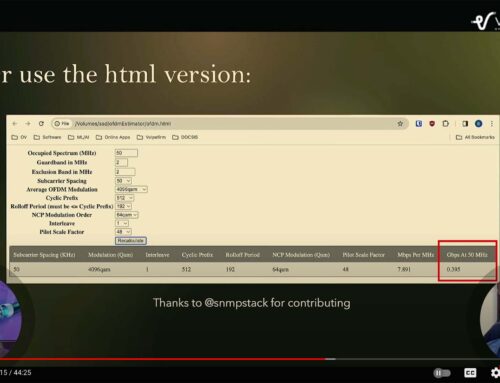DOCSIS 3.1 In Your Plant Now
In last month’s article we focused on demystifying OFDM in DOCSIS 3.1. If you did not read the article please do, because we are going to now build on what we learned last time in the Broadband Library DOCSIS Online article titled “OFDM, completely new in DOCSIS 3.1”. You can find it in the archives with this link: bit.ly/OFDM3 – Also, for those not familair with bit.ly, its just a URL shortening service. Just click on the link or type it into your browser and it will take you to the site. It’s completely safe and I prefer them over long URLs.
This month we will go into more depth of the new DOCSIS 3.1 PHY (physical layer) specification so that you can get more comfortable on how the downstream OFDM channels are configured. We do this because there is a lot of confusion around how flexible DOCSIS 3.1 really is. I’ve spoken to a number of cable operators who believe they must replace all equipment (nodes, amps, passives, etc.) in their plant in order to support DOCSIS 3.1 and this is not true. DOCSIS 3.1 can be supported on most HFC networks as they are today. This is a great feature of DOCSIS 3.1, so let’s understand how this is possible.
Downstream CMTS Spectrum
The DOCSIS 3.1 PHY specification states that all DOCSIS 3.1 CMTSs must support a downstream of 1.218 GHz. Does this mean that you must expand your RF plant to 1.218 GHz for DOCSIS 3.1? Absolutely not. DOCSIS 3.1 will run on whatever bandwidth plant you currently have – even that 550 MHz plant, but for reasons we will discuss shortly, I would not recommend it.
The 1.218 GHz downstream spec came about because many plants have been upgraded to 1 GHz equipment. Most equipment vendors extend the bandwidth of their equipment beyond 1 GHz to ensure proper operation out to 1 GHz. This region beyond 1 GHz where the equipment is not specified is called the roll-off region. Normally we would never run an SC-QAM channel in this region because SC-QAM channels are sensitive to roll-off. Testing has shown that OFDM channels will effectively operate in the roll-off region, which means we can take advantage of the RF spectrum beyond 1 GHz, possibly all the way out to 1.218 GHz, which is why the spec was written as such.
The DOCSIS 3.1 CMTS must support a lower band edge of 258 MHz and should support a lower band edge of 108 MHz. I’m making this clear because there are some cable operators – you know who you are – that like to use some pretty low frequencies for your DOCSIS channels. As you start to look at a DOCSIS 3.1 migration you will need to free up bandwidth in the higher frequency ranges, typically above 258 MHz for your DOCSIS channels. Although a DOCSIS 3.1 CMTS will still be able to support your legacy DOCSIS 2.0 and 3.0 modems, provided they are within the supported frequency range of 258 MHz (must) or 108 MHz (should) requirements.
Upstream CMTS Spectrum
Do I need to increase my upstream to 85 MHz or even 204 MHz to support DOCSIS 3.1? Absolutely not. While the cable modem must support upstream transmission from 5 to at least 204 MHz, DOCSIS 3.1 cable modems will still happily operate on a 5-42 MHz return (5-65 MHz in Europe or Asia).
Further, DOCSIS 3.1 modems can also operate in DOCSIS 3.0 mode supporting existing ATDMA modes of operation along with your existing DOCSIS modems for channel bonding and even load balancing. A unique feature of DOCSIS 3.1 CMTSs and modems is that they can operate in coexistence mode. This means DOCSIS 3.1 modems can operate in OFDMA mode on the same frequency as DOCSIS 3.0 modems transmitting in QAM (ATDMA) modem. The DOCSIS 3.1 CMTS allocates time slots to DOCSIS 3.1 modems and DOCSIS 3.0 modems so that they can coexists on the same frequency, but in the optimum modulation format for the modem type. This is very useful as cable operators transition DOCSIS 3.0 modems to DOCSIS 3.1 modems.
Eventually it will be desirable to increase upstream bandwidth. In order to do this many cable operators are looking at expanding the return to 85 MHz or higher. This allows us to eventually increase the upstream channel size of DOCSIS 3.1 and see much higher upstream bandwidths, but keep in mind that this is not something that needs to be done in the near term. Most systems are struggling to keep up with downstream bandwidth requirements today. The upstream is not the limiting factor. So upgrading the return path can be pushed off to a later budget cycle.
OFDM and OFDMA Channel Size
What about the actual OFDM channels themselves? Many people have been told that they are 192 MHz wide. Freeing up 192 MHz of downstream spectrum may be difficult, if not impossible.
While a 192 MHz is the maximum downstream OFDM channel a DOCSIS 3.1 CMTS must support a minimum downstream OFDM channel size of 24 MHz. The actual channel size is 22 MHz, but we must allow for a 1 MHz buffer on each side before we can place any other channel. That is actually a pretty small channel considering four (4) standard 6 MHz bonded DOCSIS channels occupy 24 MHz.
Similarly, in the upstream the maximum OFDMA channel bandwidth is 96 MHz, which is impossible to do on a 5-42 MHz return. However, depending on the mode used in the upstream, the smallest OFDMA upstream channel bandwidth is 6.4 MHz. That is the same bandwidth many cable operators are using today for DOCSIS 3.0 in ATDMA mode. Again, this is reinforcing that DOCSIS 3.1 is very possible on existing HFC networks with no changes.
OFDM vs. OFDMA
I have been using the terms OFDM in the downstream and OFDMA in the upstream and need to provide proper clarification.
In the last Broadband Library article we clearly defined OFDM as orthogonal frequency division multiplexing. In OFDMA we added the letter ‘A’ to end of OFDM. The letter ‘A’ is of significance in the upstream in the same way it was for TDMA and ATDMA in DOCSIS 1.x and 2.0/3.0. Each cable modem transmits only for a very short duration, which many refer to as a burst. In pre-DOCSIS 3.1 this is referred to as time division multiple access and is described more thourghly in this article bit.ly/BV_TDMA. The ‘A’ at the end of TDMA stands for access and is the key descriptor letting us know that the upstream is a shared medium for many cable modems.
Think of the upstream with many cable modems as a classroom full of young students and the CMTS as the teacher. Each time a student wants to ask a question they must ‘A’sk for permission to speak. This is the access part of TDMA. The same holds true for OFDMA in the upstream, again where the ‘A’ at the end of OFDMA stands for access in orthogonal frequency division multiple access.
Fundamentally the technology of OFDMA is quite similar to OFDM, but we have many cable modems that are sharing the same frequency and must ‘A’sk the CMTS for permission to transmit on the upstream.
Closing Thoughts
When the DOCSIS 3.1 specification was under development there was a lot of concern over the peak power created by pilot channels. The pilot channels are evenly spaced between the sub-carriers and are necessary for OFDM demodulation at the receiver. The pilot channels are transmitted at a higher level than the sub-carriers and create what is called a peak-to-average power or PAPR. Given a 192 MHz OFDM channel, it was originally thought that this would cause significant distortions in RF amplifiers and nodes unlike SC-QAM channels, whose output is at that same RF level across the top of the QAM channel. As DOCSIS 3.1 has matured and real-world testing has demonstrated, OFDM offers ways of reducing peak-to-average power and this has not been an issue in the downstream.
The upstream is expected to be more problematic than the downstream due to analog return path transmitters. So long as OFDMA channel bandwidths are reasonably small in the upstream we expect that return path lasers will not be impacted. However, as OFDMA channel bandwidths are increased to say 96 MHz, PAPR will become problematic and laser clipping is likely to occur. This will necessitate the need for a remote PHY solution. The remote PHY is when the CMTS return is moved into the fiber node and analog return path transmitters are replaced by a digital link.
While I’m bringing up the issue of PAPR in the upstream, this is only to address an issue in the future. Once again, the focus of this article is make all cable operators aware is that DOCSIS 3.1 offers amazing speed increases and built-in test capabilities as I have discussed in previous Broadband Library articles. More importantly, you can start budgeting for DOCSIS 3.1 now and plan to install it in your existing plant without the need to upgrade your plant. Plant upgrades can come later as higher speed requirements deem necessary.





This looks like something i should have watched in school